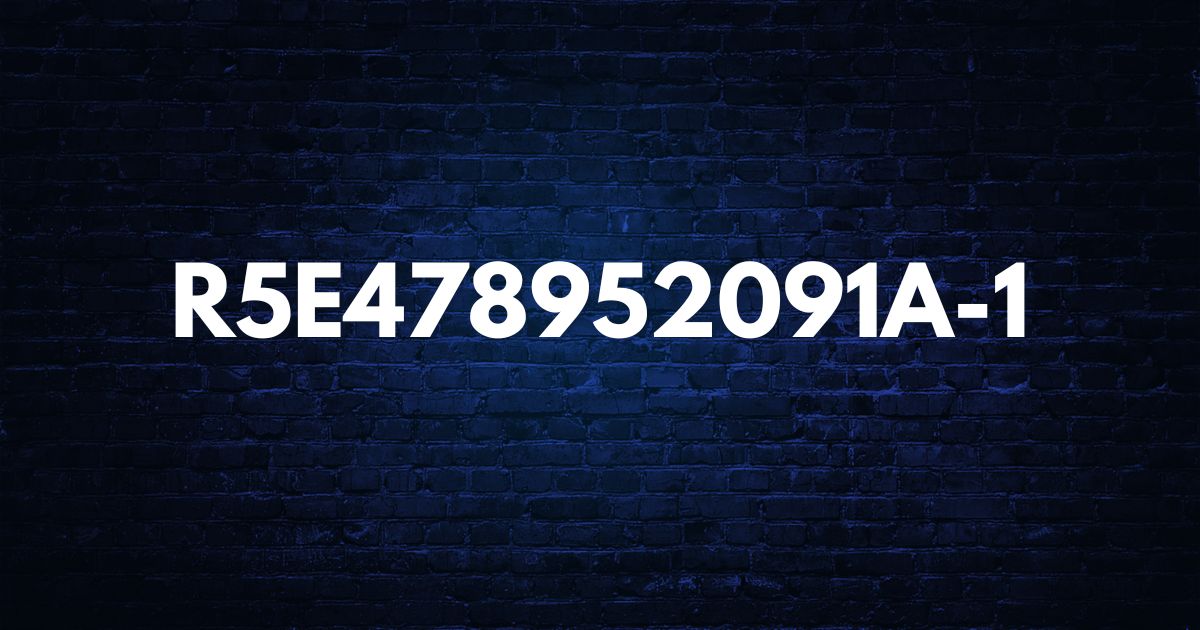Contents
R5E478952091A-1 is a reference that may sound cryptic to some, but for those who work with specific technical systems, tools, or processes, it represents a critical identifier. Whether it pertains to a part number, a specific code in an industrial system, or an asset in a technological framework, such identifiers hold immense importance in ensuring precision, functionality, and continuity. This article delves into the depth of what R5E478952091A-1 might signify, exploring its implications, uses, and why such identifiers are indispensable in modern systems.
The Importance of Systematic Identification
In the intricate world of engineering, manufacturing, and technology, identifiers like R5E478952091A-1 serve as the backbone of operational efficiency. These codes ensure that every component or system element is uniquely recognizable, facilitating seamless communication and collaboration among stakeholders. Without precise identification, processes would face risks of inefficiency, errors, and mismanagement. Take, for instance, a manufacturing plant that relies on hundreds of unique parts to assemble its products. A single misstep in identifying a part could lead to costly delays or even malfunctioning machinery. Codes like R5E478952091A-1 eliminate ambiguity, ensuring that the right component is used at the right time and in the correct application.
Applications of R5E478952091A-1 in Modern Industries
Although R5E478952091A-1 may be a placeholder or specific to a niche, its applications are indicative of how such identifiers operate in various industries. In manufacturing, such codes are often associated with spare parts, equipment modules, or specific instructions. For instance, a machine may break down, requiring the replacement of a single part. The identifier ensures that technicians can source the correct component without room for error. Similarly, in the tech industry, codes like R5E478952091A-1 could represent firmware versions, software builds, or specific digital assets. These references allow developers and technicians to track updates, compatibility, and system configurations with precision. The result is a streamlined workflow where errors are minimized, and efficiency is maximized.
Precision in Supply Chain Management
One of the most critical areas where identifiers like R5E478952091A-1 come into play is supply chain management. In a globalized economy, where products are sourced, manufactured, and shipped across continents, precision is non-negotiable. A unique identifier ensures that a component destined for a factory in one part of the world is not mistakenly shipped elsewhere. Moreover, these codes play a vital role in tracking inventory and managing logistics. Advanced systems use identifiers to monitor the movement of goods in real-time, ensuring that every component arrives at its destination as planned. This meticulous tracking not only enhances efficiency but also reduces the risk of theft, loss, or damage.
Technological Integration and Automation
As industries increasingly embrace automation and the Internet of Things (IoT), identifiers like R5E478952091A-1 become even more essential. Automated systems rely on such codes to execute tasks with minimal human intervention. For instance, a robotic arm in a factory may rely on identifiers to select the correct tool or material for a task. In the IoT ecosystem, where devices communicate with one another, identifiers facilitate seamless data exchange. A sensor transmitting data to a central server might use an identifier to label its readings accurately. This precision ensures that the data collected can be analyzed and acted upon without confusion.
Ensuring Compliance and Quality Control
In regulated industries such as pharmaceuticals, aerospace, and healthcare, compliance with strict quality standards is mandatory. Identifiers like R5E478952091A-1 play a crucial role in ensuring that every component, material, or product meets these standards. For instance, in the pharmaceutical industry, each batch of medication may be assigned a unique code. This code allows regulators and manufacturers to trace the batch’s origin, production process, and distribution. In the event of a recall, such identifiers enable swift and precise action, protecting consumers and maintaining trust in the system.
The Evolution of Identification Systems
The use of identifiers like R5E478952091A-1 is not a new concept. Historically, industries have relied on various methods to label and track components. However, technological advancements have revolutionized these systems, making them more sophisticated and reliable. Modern identification systems often integrate with technologies like barcodes, QR codes, and RFID (Radio Frequency Identification). These advancements allow identifiers to be scanned and processed instantly, eliminating manual errors and speeding up workflows. The result is a more efficient and reliable system that can keep up with the demands of a fast-paced industrial environment.
The Role of Identifiers in Data Analytics
In today’s data-driven world, identifiers like R5E478952091A-1 are instrumental in gathering and analyzing information. By tagging every component or asset with a unique code, organizations can collect granular data about their operations. This data can then be analyzed to identify trends, optimize processes, and make informed decisions. For instance, a logistics company might use identifiers to track the performance of its delivery network. By analyzing data associated with these codes, the company can pinpoint bottlenecks, improve delivery times, and enhance customer satisfaction. This level of insight would be impossible without the precision offered by systematic identification.
Challenges in Managing Identifiers
Despite their many advantages, managing identifiers like R5E478952091A-1 comes with its challenges. One common issue is the risk of duplication, where two components or assets are mistakenly assigned the same code. Such errors can lead to confusion and disrupt operations. To address this, organizations must implement robust systems for generating and managing identifiers. Automated tools can help ensure that every code is unique and accurately recorded in a central database. Regular audits and checks further minimize the risk of errors, maintaining the integrity of the system.
Conclusion
R5E478952091A-1 may seem like a simple string of characters, but its significance in modern systems cannot be overstated. From ensuring precision in manufacturing to enabling seamless communication in IoT ecosystems, such identifiers are the unsung heroes of efficiency and reliability. As industries continue to evolve and embrace new technologies, the role of identifiers like R5E478952091A-1 will only grow in importance. By understanding their applications and implications, organizations can harness their full potential, driving innovation and success in an increasingly complex world.
FAQs
What is the purpose of R5E478952091A-1?
R5E478952091A-1 is a unique identifier used to precisely label and track specific components, systems, or assets in industries like manufacturing, technology, or logistics. It ensures accuracy and eliminates ambiguity when managing processes or parts.
In which industries is R5E478952091A-1 commonly used?
Identifiers like R5E478952091A-1 are widely used in industries such as manufacturing, technology, supply chain management, healthcare, and aerospace. They facilitate operations like inventory tracking, compliance, and quality control.
How do systems recognize R5E478952091A-1?
Modern systems use technologies like barcodes, QR codes, or RFID tags to scan and identify codes such as R5E478952091A-1. These tools automate the process, ensuring precision and efficiency.
What happens if an identifier like R5E478952091A-1 is duplicated?
Duplication of identifiers can lead to confusion, errors, and operational delays. To avoid this, robust systems for generating and managing unique identifiers are essential, alongside regular audits to maintain system integrity.
How does R5E478952091A-1 contribute to data analytics?
R5E478952091A-1 helps tag and organize data, making it easier to track trends, optimize processes, and make data-driven decisions. For example, logistics companies can analyze delivery times using such identifiers to improve service quality.











